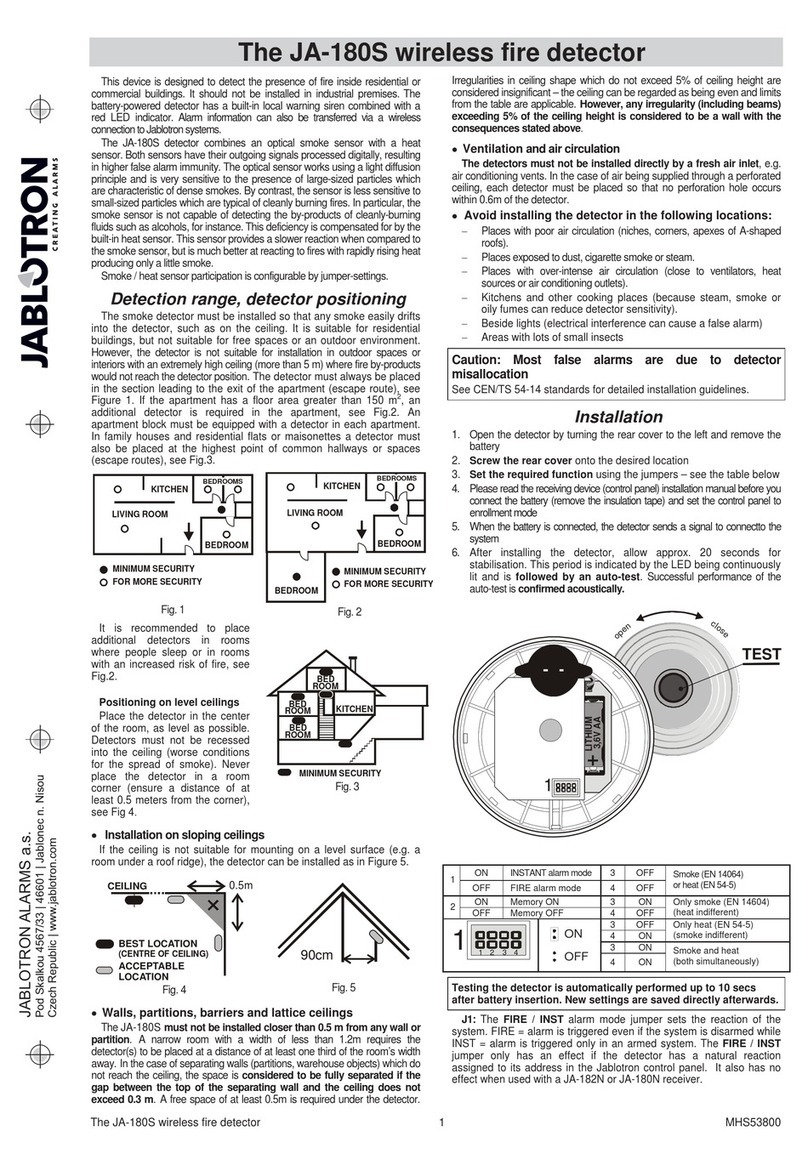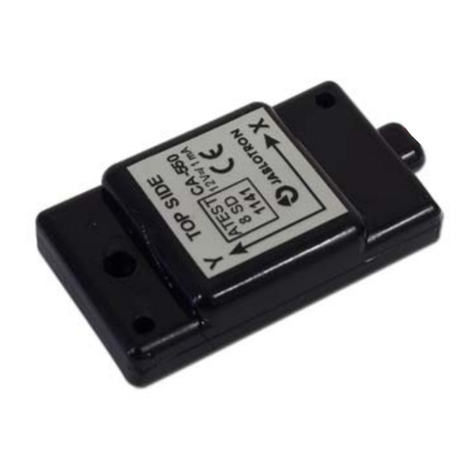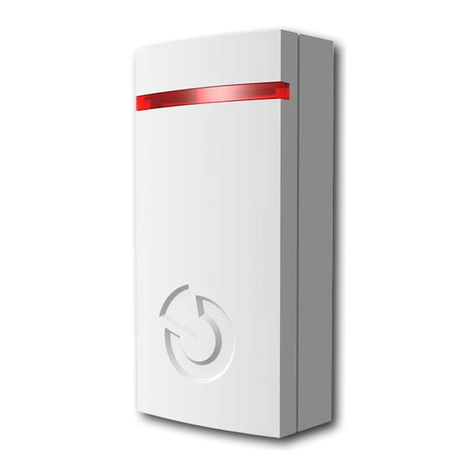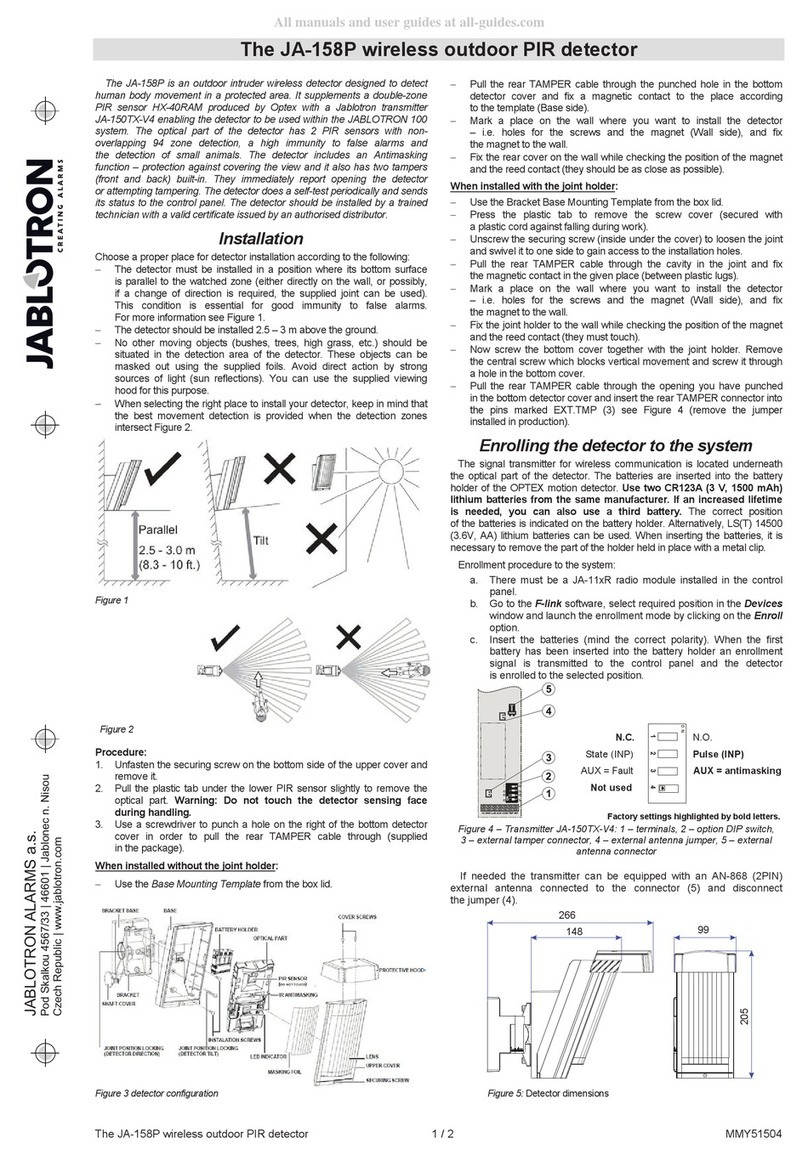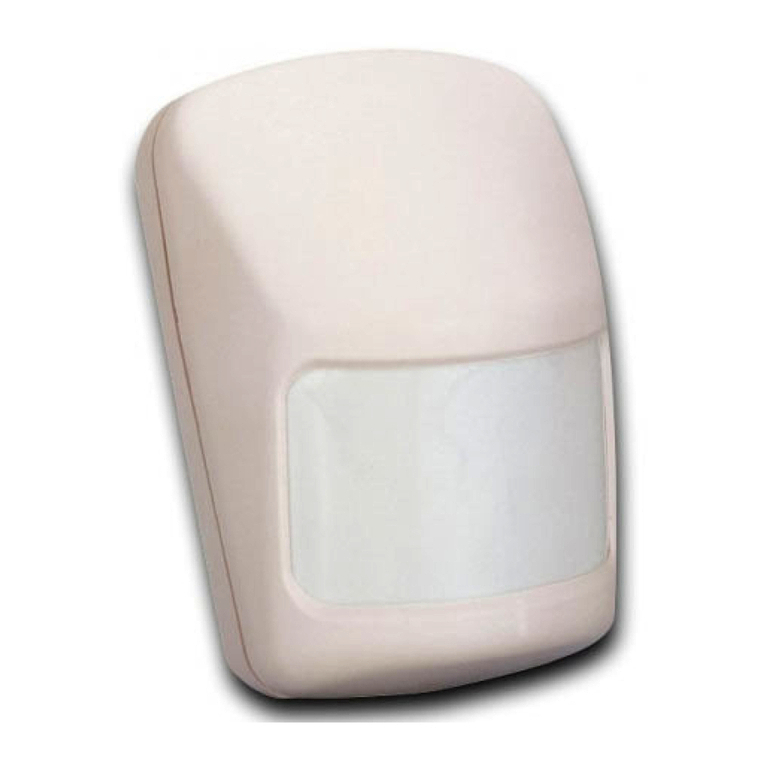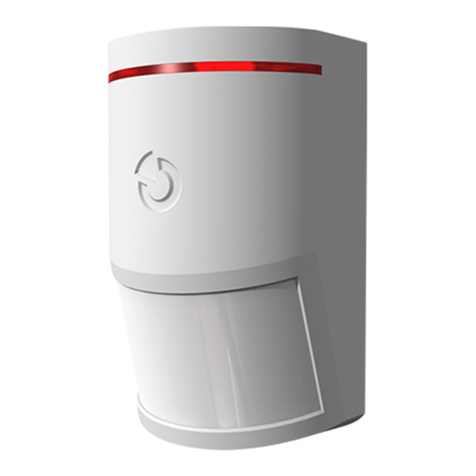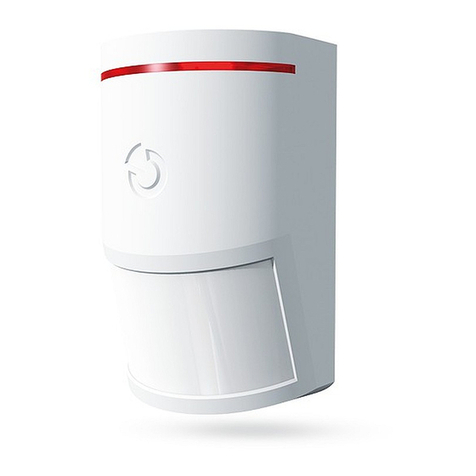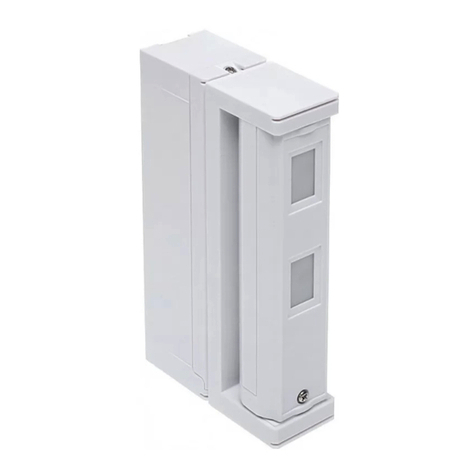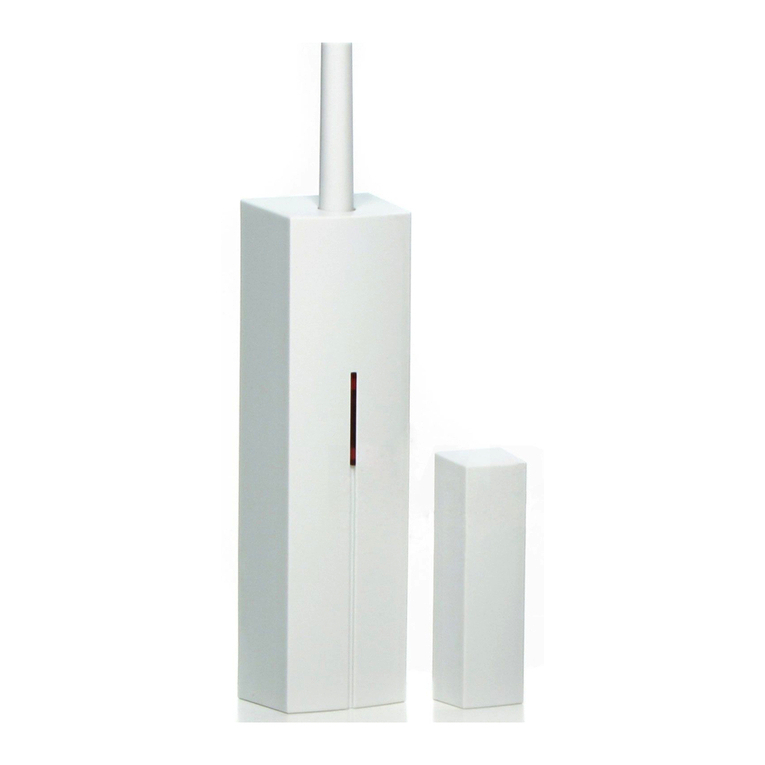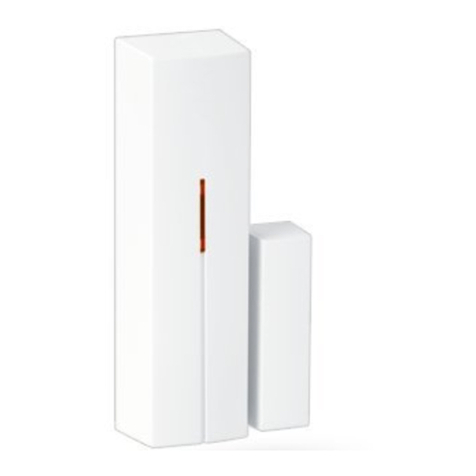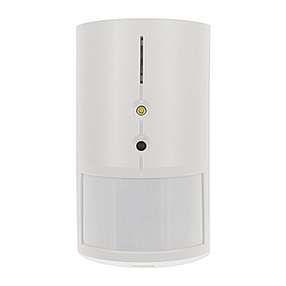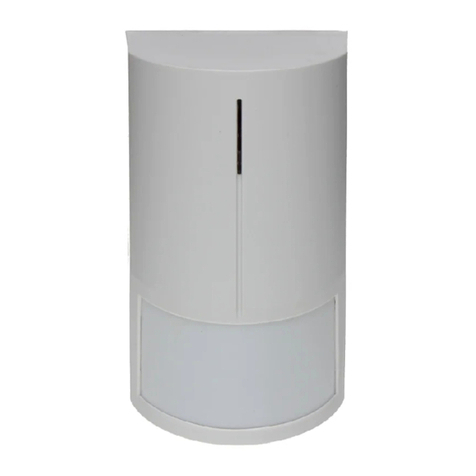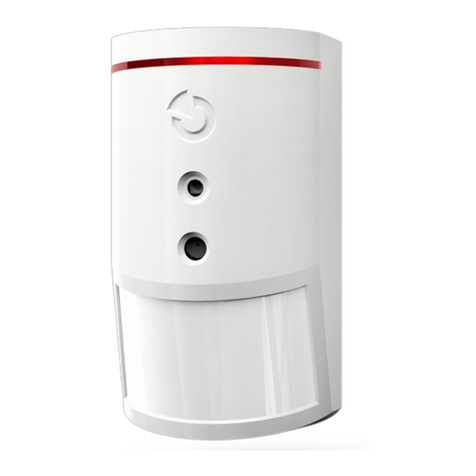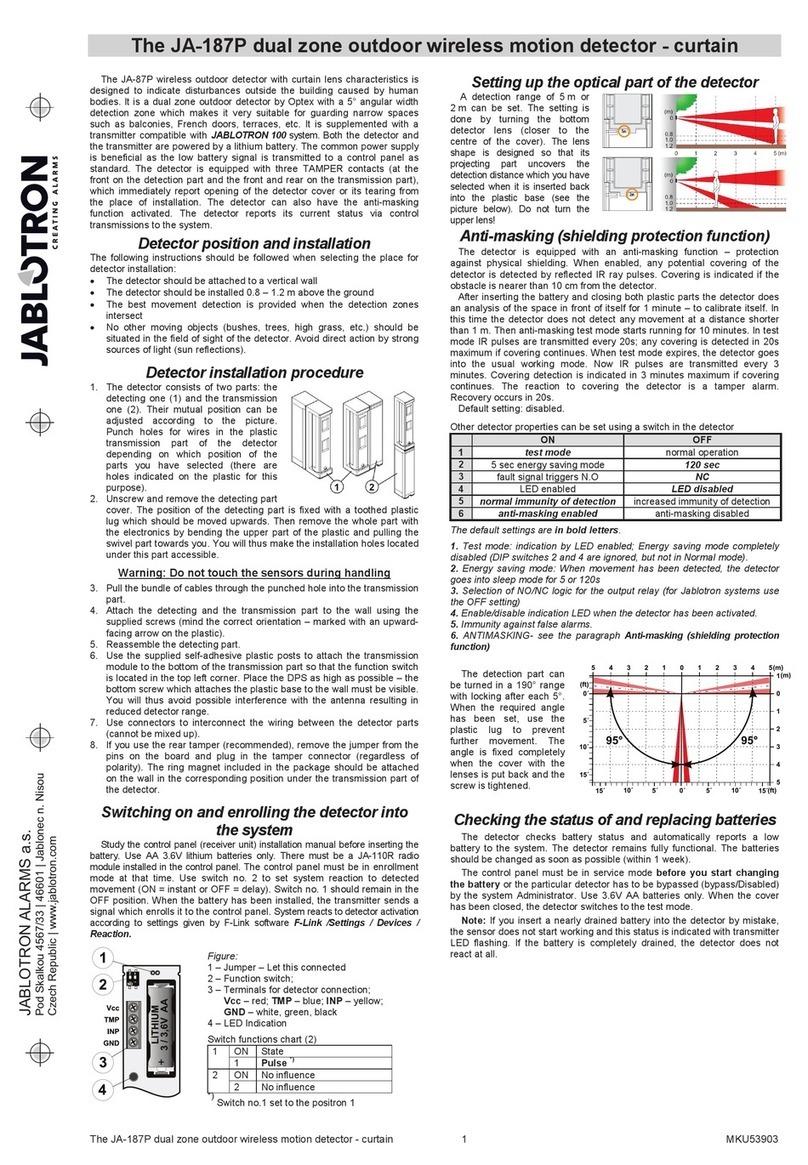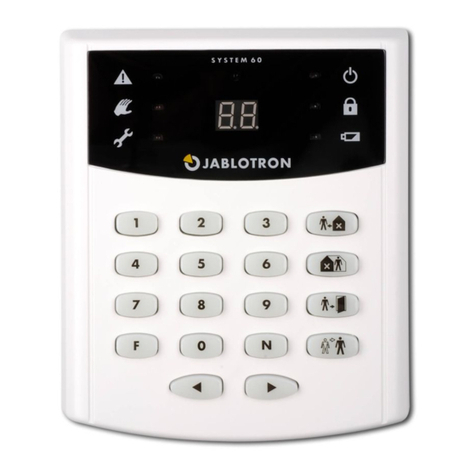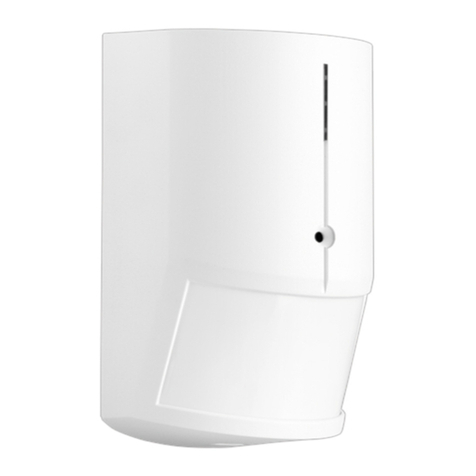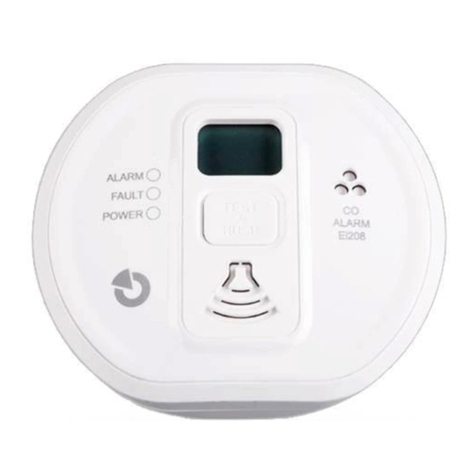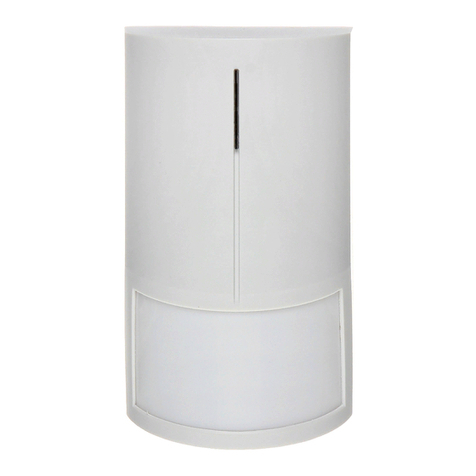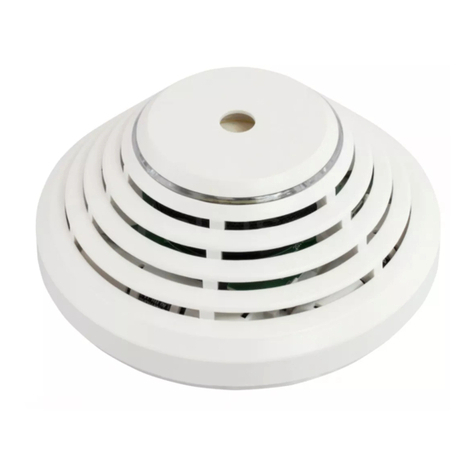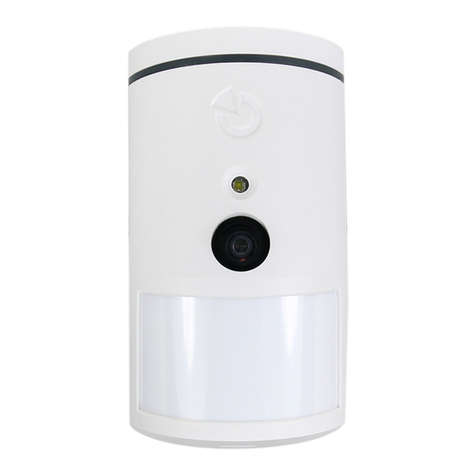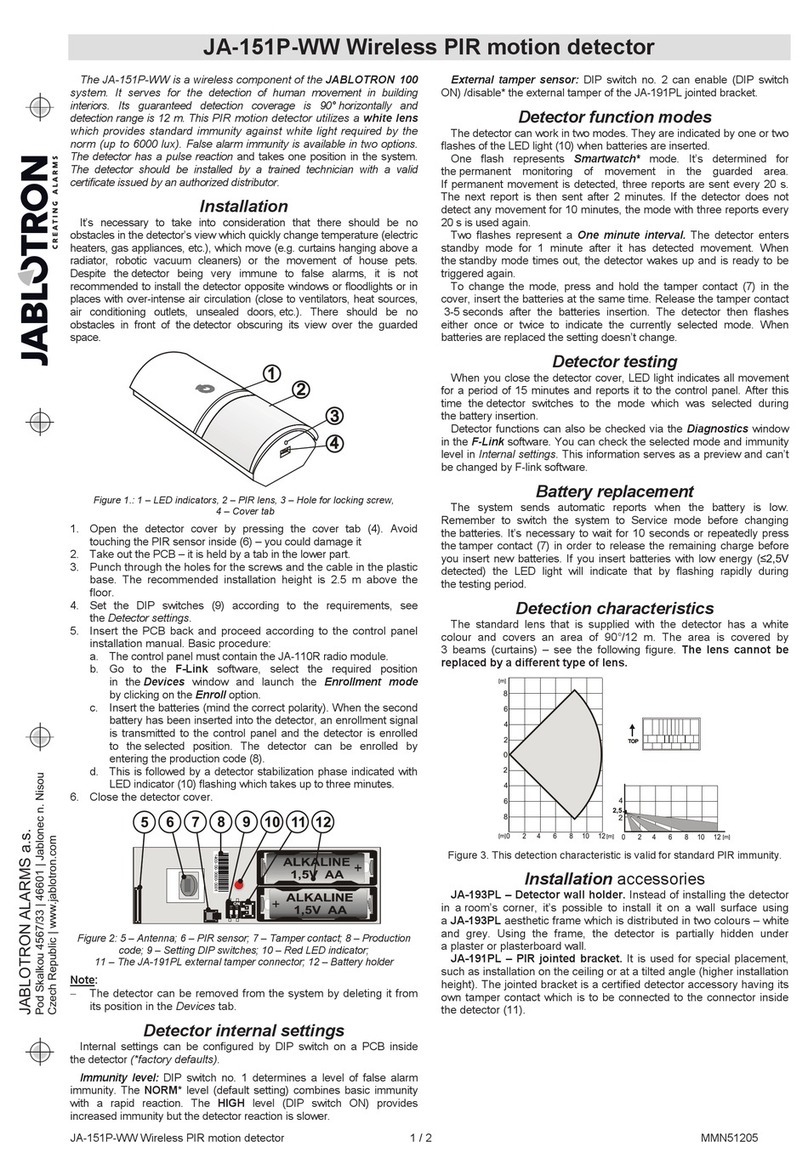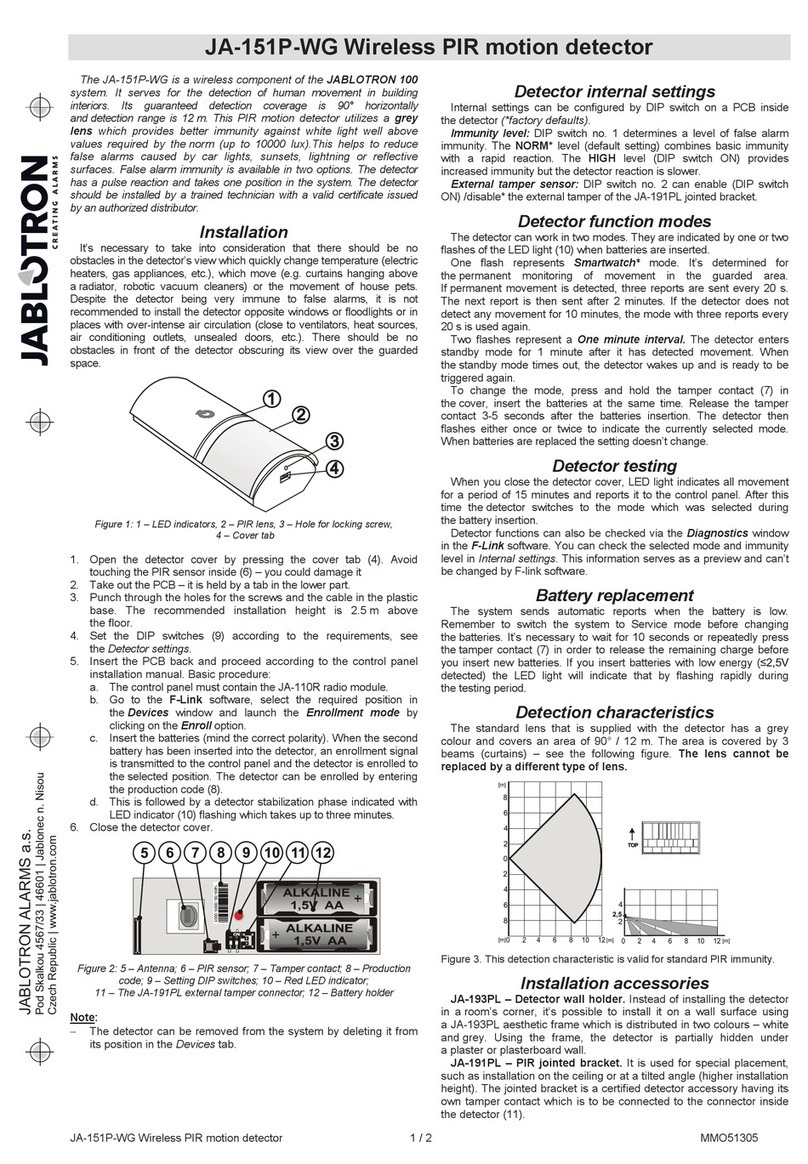
JA-84P wireless motion detector with built-in camera 2 / 2 MHP56106
5 minute / 1 minute sleep time
To save battery energy, the detector switches to battery-saving mode 15
minutes after its cover is closed. The detector still watches for movement
during battery-saving mode.
The first movement detected is instantly transmitted to the control panel,
and for the next 5 minutes the detector ignores any further movement.
After these 5 minutes, the detector then returns to watching out for
movement until it is re-triggered. The sleep time can be shortened to 1
minute by pressing the tamper switch during battery installation. Not pressing
the tamper switch gives a sleep time of 5 minutes.
Camera testing
Switch the control panel to SERVICE mode and have an RC-80 key-fob
ready.
1. Open and close the detector’s cover again. Its green indicator will turn
on for 10 sec (enrollment mode to enroll the key-fob as a remote trigger
for testing the camera)
2. Enroll the key-fob by pressing any key (a green LED flash confirms
enrollment)
3. Use the key-fob to take photos: = snap without flash, = snap
with flash
4. Camera test mode lasts for 15 minutes then the key-fob is automatically
erased from the detector. If you want another 15 minutes testing, repeat
the above procedure starting from 1. Test mode can be finished
immediately by pressing and simultaneously.
After it has been taken the photo is transmitted to the control panel -
indicated by green LED flashing. Successful transmission is confirmed by a
long green flash (2 sec). Unsuccessful transmission is indicated by a series
of rapid green flashes at the end. The transmission is also indicated on the
JA-80Q data module (same logic).
After the photo is received by the control panel, the data module transfers it
to the server (via the communicator). This transfer is indicated by a red LED
flashing on the JA-80Q module. Successful transfer is confirmed by a long
red flash (2 sec). Unsuccessful transfer is indicated by a series of rapid red
flashes at the end.
The total average time to transfer the photo from the camera to the server
is about 20 sec. In the case of radio signal interference the transfer can be
longer (damaged data are repeated). Each photo also contains a date and
time stamp.
If the photo transfer was not successful, the photo will only stay in the
detector’s internal memory.
Normal camera operation
15 minutes after closing the cover, the detector changes from test mode to
normal operational mode (the test key-fob is erased and the red LED turns off).
If the control panel is unset (disarmed), the detector ignores movements
and takes no photos.
During the exit delay the detector reports movements but takes no
photos.
During the entrance delay the detector – when triggered – not only
reports a movement but also instantly takes one photo without a flash. The
photo is then stored in memory. For the next 5 seconds from the moment of
taking the photo shot, the detector goes to sleep mode. After that the
detector returns to watching out for movement. Any further detection of
movement is reported and responded to according to whether the system is
in an entrance delay state and/or alarm condition. If an entrance delay is still
occurring, the detector will not take or store pictures any more. If an alarm
state is indicated, the detector will take photos the same way as if a
movement had been detected in an instant loop (see below). If an alarm
triggered due to an entrance delay has expired (so that no other detectors
have been triggered), then the memorized photo taken during first movement
detection is transmitted.
Instant-loop movement detection is reported to the control panel and a
series of 4 photos is taken by the camera. The first photo is taken instantly
without a flash. The following 3 pictures are taken at one second intervals,
each with a flash. After that any movement in the detection area is ignored
and the pictures are transferred to the control panel. The detector’s inactivity
period ends 5 seconds after finishing picture transmission.
Alarm verification and flash functions
The main task of the built-in camera is to verify real alarms caused by
human body movement (to recognize false alarms).
The detector’s built in flash illuminates the scene, but it also has another
important functions patented by Jablotron:
a) An unexpected flash attracts the intruder to look at the detector and
this significantly increases the probability that the next shot will show
the intruder’s face
b) A flash also clearly indicates, to the intruder that he was detected,
possibly making him run away. If not and (s)he tries to damage the
detector, a tamper alarm is triggered. The tamper alarm will verify the
intruder’s presence even faster than photo transmission does.
Stand alone mode
In this mode the photos will only be stored locally in the detector’s internal
memory (last 61 shots). This mode starts automatically when the detector is
not enrolled to any control panel after inserting batteries.
After the end of the walk test period (15 minutes) every movement in front of
the detector will trigger taking three photos and storing them in the internal
memory. Then the 5 / 1 minute sleep period starts. The flash can be enabled /
disabled using the DIP switch. The transmit function is disabled automatically.
Note: No date and time stamps are applied to the photos when the device
operates in stand-alone mode.
Viewing photos from the detector’s internal memory
The detector stores the last 61 photos in its internal memory. The photos
can be viewed by a PC:
1. Switch the control panel to SERVICE mode
2. Open the detector and disconnect the camera module’s cable
3. Take the cover with the camera to the PC and use the cable (provided
with the JA-80Q data module) to connect it to the PC USB port
4. The camera module is accessible as a removable mass storage device.
Photos are stored in BMP files. Use a suitable viewer (i.e. “Windows
photo and fax viewer”) to view the photos.
5. After viewing the photos reinstall the camera module in the detector and
switch the control panel to normal operational mode.
Battery replacement
The detector monitors the voltage of its batteries and if too low, a report is
sent to the control panel to inform the installer or user. The detector continues
to function and shows each detected movement with a flash of its red LED.
Battery replacement should not be delayed by more than two weeks. This
should be done by a qualified technician with the control panel in Service mode.
After battery replacement, the detector needs about 100 sec to stabilise during
which its red LED lights continuously. After the LED has stopped indicating, test
that the detector is functioning (it will be in test mode for 15 minutes).
Always use new batteries and replace both of them. Be careful not to mix
used and new batteries (even a nearly discharged lithium battery has 3V so it
is not simple to recognize a discharged battery).
Expired batteries should not be thrown into the garbage, but disposed of
according to local regulations.
Removing the detector from the system
If a detector is removed, the control panel reports its removal. The detector
has to be deleted from the control panel before intentional removal.
Technical parameters
Voltage: 2x Lithium battery type CR123 (3.0V / 2,4Ah)
Please note: Batteries are not included
Typical battery lifetime: approx. 2 years (one alarm / month, DEL reaction)
Communication band: 868 MHz, Oasis protocol
Communication range: max. 300m (open area)
Recommended installation height: 2.0 to 2.5 m above floor level
Installation height acc. Incert T014A. 2.0 to 2.4 m above floor level
PIR detection angle/detection range: 50° / 12 m (basic lens)
Resolution of the camera 160 x 128 pixels, B&W
Internal memory photo format bit map (BMP)
Format of the photos transmitted to server JPG
Horizontal camera capture angle 50°
Range of the flash max. 3 meters
Typical photo transmission time to the control panel 25 sec
Typical photo transfer time from the system to server 15s/GPRS (JA-80Y)
2s /LAN (JA-80V)
EN 50131-1,EN 50131-2-2, EN 50131-5-3 classification: grade 2
Operational environment according to EN 50131-1 II. indoor general
Operational temperature range -10 to +40 °C
Dimensions 110 x 60 x 55 mm
Complies with ETSI EN 300220, EN 55022, EN 50130-4, EN 60950-1
Can be operated according to ERC REC 70-03
FCC ID: VL6JA84P
INCERT no.: B-903-0001
JABLOTRON ALARMS a.s. hereby declares that the JA-84P is in
a compliance with the relevant Union harmonisation legislation:
Directives No: 2014/53/EU, 2014/35/EU, 2014/30/EU,
2011/65/EU. The original of the conformity assessment can be
found at www.jablotron.com - Section Downloads.
: Although this product does not
contain any harmful materials we
suggest you return the product to the
dealer or directly to the manufacturer
after use.
